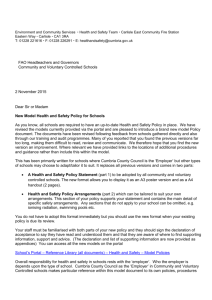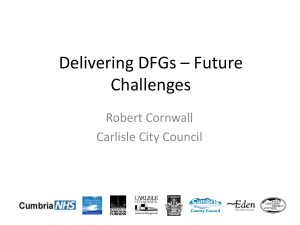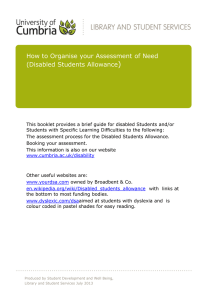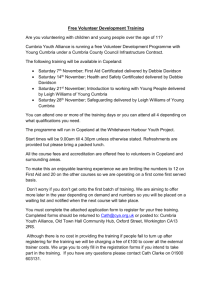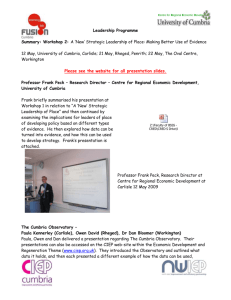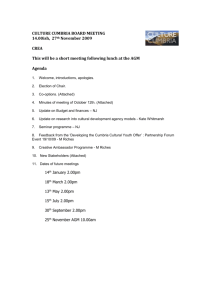Cumbria Profile - Cumbria County Council
advertisement
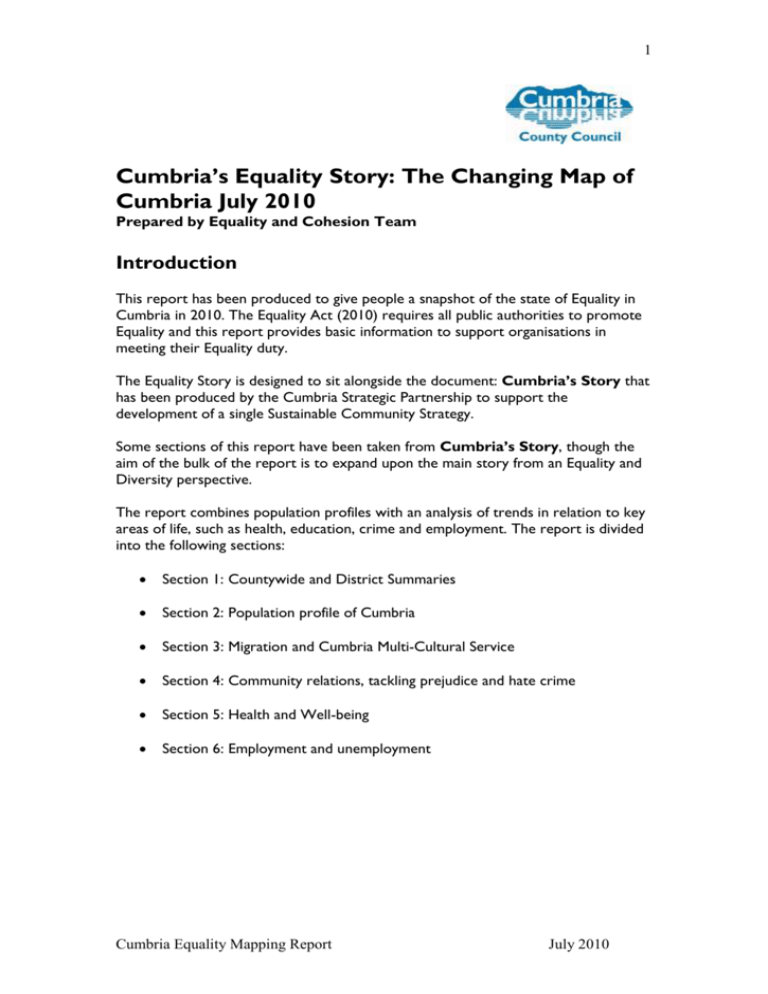
1 Cumbria’s Equality Story: The Changing Map of Cumbria July 2010 Prepared by Equality and Cohesion Team Introduction This report has been produced to give people a snapshot of the state of Equality in Cumbria in 2010. The Equality Act (2010) requires all public authorities to promote Equality and this report provides basic information to support organisations in meeting their Equality duty. The Equality Story is designed to sit alongside the document: Cumbria’s Story that has been produced by the Cumbria Strategic Partnership to support the development of a single Sustainable Community Strategy. Some sections of this report have been taken from Cumbria’s Story, though the aim of the bulk of the report is to expand upon the main story from an Equality and Diversity perspective. The report combines population profiles with an analysis of trends in relation to key areas of life, such as health, education, crime and employment. The report is divided into the following sections: Section 1: Countywide and District Summaries Section 2: Population profile of Cumbria Section 3: Migration and Cumbria Multi-Cultural Service Section 4: Community relations, tackling prejudice and hate crime Section 5: Health and Well-being Section 6: Employment and unemployment Cumbria Equality Mapping Report July 2010 2 Section 1: Countywide and District Summaries The aim of these findings is to inform local level Equality priority setting. The focus is upon statistical patterns that may indicate discrimination or unfair treatment. There is a profile for the County and for each District. Countywide findings Diversity Theme Details of finding Strand Age Employment 22% of 20-24 year olds in April 2009 were claiming Job Seeker Allowance, compared with an average across all age groups of 8.7% More people aged 24 and under are on Job Seeker Allowance in Cumbria than in the North West and England Belonging to People aged 18-24 less likely than other age groups to feel local area their belong to the local area. Population More males than females for people below 25, and more and gender females than males (by 1%) for people aged 80+ Gender Violence The total estimated costs of violence against women and against girls is £151m per annum in Cumbria women and girls Health Life expectancy for males is below national average in Allerdale, Barrow, Carlisle and Copeland Disability 69% of people on Attendance Allowance are women – and gender suggesting women are overrepresented as carers. Males claiming a life long limiting condition is higher than females. Employment The % of women who are economically active is – compared lower in Cumbria to North The % of women who are self-employed is lower in West and Cumbria England The % of women who are employees is higher in Cumbria Disability Socioeconomic status Ethnicity Population 2008 Place Survey suggests that Cumbria has a higher than average population of people who have long term limiting health conditions Population – Higher than national average % of people classified as hard ‘struggling families’ pressed Population Significant increase in BME people across the whole county. Migration Approximately 2000 people arriving in Cumbria each year. The recession has seen a decrease but the rate is still above 2004. Belonging to BME people 15% less likely than White British People to feel local area they belong to the local area Cumbria Equality Mapping Report July 2010 3 Religion/ belief Sexual orientation Access to services Access to services Census 2001 Civil partnerships Allerdale findings Diversity Theme Strand Age Population Gender Health Disability Socioeconomic status Ethnicity Details of finding Decline in people aged 0-14 Life expectancy for males is below the national average Life expectancy for females is lower than the national average and second lowest in Cumbria after Copeland. Population Above average % of people classified as Hard Pressed: 17% households described as struggling families. Population Moss Bay is Cumbria’s 3rd highest ward for % of people described as Hard Pressed (81.5%). Moorclose, Ewanrigg and Flimby wards are also in the Cumbria top 10. % change in the BME population in Allerdale between 20017 is greater than the county average. Hate incidents above county average Below county average % people who think people from different backgrounds get on Population Crime Community NI 1 Cohesion Barrow findings Diversity Theme Strand Age Population changes – impact of population shrinkage Gender ESOL: Chinese people significantly less likely to access ESOL following introduction of charging. ESOL: No records of Asian male learners in 2077-8 and 2008-9 Cumbria has higher than national average number of Christians 60% of civil partnerships have been female. Details of finding Highest rate of decline of people aged 0-14 in Cumbria. Significant decline of people aged 30-44 (potentially linked to the decline in 0-14 as this the main group who would be parents). Only District with a declining population aged 75-84. Fastest rate if rise in population aged 85+ Employment Barrow has the highest levels of unemployment for those aged 25-29years (14.7%). Barrow has the highest rates of unemployment for people aged 24 and under. Population 2nd highest % of lone parent households, equal to national average (2001 Census) Ratio of male to female unemployment is joint second highest with Copeland. Cumbria Equality Mapping Report July 2010 4 Health Disability Population Socioeconomic status Population Benefits Benefits Ethnicity Crime MultiCultural Service Males have the lowest life expectancy of any district and below the national average. Female life expectancy is lower than the national average, but above Copeland and Allerdale. Highest % of households in 2001 reporting someone with a long term limiting condition. Barrow has the highest % of people classified as on ‘Moderate Means’ Highest proportion of population on incapacity benefits Joint highest proportion of lone parents on benefits with Copeland. Highest rate of hate crime per 100,000 people Demand in Barrow for the Multi-Cultural Service was higher than other parts of Cumbria for the following: Immigration Benefits Utilities Housing Health Carlisle findings Diversity Theme Details of finding Strand Age Employment Carlisle has the highest unemployment rate in the 3034years category (10.4%). Unemployment for people aged 24 and under is equal to the county average and higher than national and North West average. Gender Health Life expectancy for males is below national average and for females at national average Employment The ratio of male to female unemployment is greater in Carlisle than other Districts SocioPopulation: Highest % of people classified as ‘burdened singles’ at 7% of economic all households. status Population Highest numbers of lone parents on benefits in Cumbria at 970 people (though less than Barrow and Copeland as a proportion of population). Population 15.7% of households described as struggling families (2nd highest in Cumbria) Population Upperby is Cumbria’s 2nd highest ward for % people who are classified as Hard Pressed (83%) Ethnicity Population In 2007 there were estimated 4,200 BME people Access to Highest % of requests for interpreters for Children’s services Services. Highest % of interpreters required for non-EU people Migration 2nd highest number of overseas migrants Cumbria Equality Mapping Report July 2010 5 Crime Religion/bel ief Sexual orientation Community People from Cohesion different backgrounds get on Belonging to the local area Hate incidents above county average Lowest level of people who think people from different backgrounds get on Lowest % of Districts who feel they belong in their local area Copeland findings Diversity Theme Details of finding Strand Age Employment Copeland has the highest level of unemployment for those aged 20-24years (24.4%) Gender Health Life expectancy is lower for women than any other District and significantly below the national average. Life expectancy is lower for men than the national average The gap in life expectancy between the wealthiest 20% and the least wealthy 20% is greater than any other District for women, and second widest for males. Employment Ratio of male to female unemployment is joint second highest with Barrow SocioPopulation Highest % of people classified as ‘Hard Pressed’. 26% of all economic households described as Struggling Families status Population Mirehouse Ward has the highest % of people classified as Hard Pressed: 85% Population Joint highest proportion of lone parents on benefits with Barrow. Ethnicity Population BME population has doubled since 2001, but is still lowest in Cumbria – 3.4% or 2,400 people. Crime 2nd highest rate of hate incidents reported to the police Community People from Below county average % people who think people from Cohesion different different backgrounds get on backgrounds get on Eden findings Diversity Theme Details of finding Strand Age Employment Over representation of in people aged 50+ on Job Seekers’ Allowance Gender Health The gap in life expectancy between the wealthiest 20% and least wealthy 20% of males is 8.9 years – the greatest intra- Cumbria Equality Mapping Report July 2010 6 gender gap in Cumbria based on income. Eden is the only area where wealth does not have an impact on women’s life expectancy. Disability Socioeconomic status Ethnicity Population MultiCultural Service 3.5% of the population (1,800 people) are estimated as BME Demand in Penrith for the Multi-Cultural Service was greater than other parts of Cumbria for the following: Working tax credit and tax queries Employment and National Insurance DVLA South Lakes findings Diversity Theme Strand Age Employment Gender Socioeconomic status Ethnicity Health: life expectancy and socio-economic status Population Population Details of finding Over representation of in people aged 50+ on Job Seekers’ Allowance The gap between wealthiest and least wealthy males is 8.9 years – greater than any other district. Kendal Kirkland and Kendal Far Cross are in the top 10 wards in Cumbria for % people classified as Hard Pressed Highest % BME people in Cumbria at 5.1% Cumbria Equality Mapping Report July 2010 7 Section 3: Population profile of Cumbria This section gives details about the population profile of Cumbria and has subsections covering: Rurality and an aging population Age and gender Ethnicity Disability Sexual Orientation Socio-economic status Religion/belief Rurality and an aging population With a population of just under 500,000 Cumbria is the second least densely populated county in England. Of Cumbria’s six districts, South Lakeland and Carlisle have the largest populations; 104,400 and 103,700 respectively. Eden has the smallest population; 51,900. Figure 1 shows how Cumbria’s population has been spread across each of its six districts each year since 1981: Figure 1: ONS Mid-Year Population Estimates: Cumbria's Districts - 1981-2008 120 Population (000s) 100 80 60 40 20 0 08 20 07 20 06 20 5 0 20 04 20 03 20 2 0 20 01 20 00 20 9 9 19 98 19 97 19 6 9 19 95 19 94 19 93 19 2 9 19 91 19 90 19 9 8 19 88 19 87 19 6 8 19 85 19 84 19 3 8 19 82 19 81 19 Allerdale Barrow-in-Furness Carlisle Copeland Eden South Lakeland Cumbria has an older population than the national average; 27% of residents are aged 60+ compared to just 22% nationally. The proportion of older residents is also increasing at a faster rate in Cumbria than it is nationally. In the last 10 years Cumbria’s 60+ population has increased by 16.1%; this compares to a national increase of just 11.6%. This trend is forecast to continue into the future driven mainly by in-migration of people aged over 45 and out-migration of younger adults. Cumbria Equality Mapping Report July 2010 8 A big challenge facing Cumbria is the number of young people who leave the county to seek opportunities, in employment and lifestyle, that they don’t yet see being offered within the county. At a district level, South Lakeland and Eden have the highest proportions of residents aged 60+. Over the last decade Eden has also experienced the biggest percentage increase in residents aged 60+, while Barrow-in-Furness and Copeland have experienced particularly large increases in the oldest age group; residents aged 85+. Figure 2 shows how the population of each district has changed over the last 10 years by age group. Figure 2: ONS Mid Year Estimates: Population Change in Cumbria's Districts - % Change Between 1999 and 2008 70 60 50 % Change 40 30 20 10 0 -10 -20 0 - 14 years 15 - 29 years 30 - 44 years 45 - 59 years 60 - 74 years 75 - 84 years 85 years and over Age Group Allerdale Barrow-in-Furness Carlisle Copeland Eden South Lakeland Age and Gender The gender split for the county and each of its six districts is more or less equal; this is also the case nationally. Looking more closely at the age and gender profile combined the following features stand out: The widest gender gaps are for ages 80-84 (1.1%) and 85-89 (1.2%), where females are greater in proportion to males. All age groups below 25-29 have slightly more males. Table1: Age and gender profile for Cumbria PERSONS ALL AGES Under 1 1-4 5-9 496,900.0 4,900.0 19,700.0 25,400.0 Cumbria Equality Mapping Report 1.0% 4.0% 5.1% MALES TOTAL % 244,200.0 2,600.0 1.1% 10,200.0 4.2% 13,000.0 5.3% FEMALES TOTAL % 252,700.0 2,400.0 0.9% 9,500.0 3.8% 12,400.0 4.9% July 2010 9 10-14 15-19 20-24 25-29 30-34 35-39 40-44 45-49 50-54 55-59 60-64 65-69 70-74 75-79 80-84 85-89 90+ 30,100.0 32,000.0 25,100.0 23,500.0 25,700.0 34,400.0 38,400.0 37,200.0 33,600.0 36,500.0 34,300.0 27,400.0 23,300.0 19,200.0 13,800.0 8,400.0 4,000.0 6.1% 6.4% 5.1% 4.7% 5.2% 6.9% 7.7% 7.5% 6.8% 7.3% 6.9% 5.5% 4.7% 3.9% 2.8% 1.7% 0.8% 15,500.0 16,800.0 13,100.0 11,900.0 12,700.0 16,600.0 19,000.0 18,800.0 16,600.0 18,100.0 17,200.0 13,500.0 11,100.0 8,500.0 5,400.0 2,700.0 900.0 6.3% 6.9% 5.4% 4.9% 5.2% 6.8% 7.8% 7.7% 6.8% 7.4% 7.0% 5.5% 4.5% 3.5% 2.2% 1.1% 0.4% 14,600.0 15,200.0 12,000.0 11,600.0 13,000.0 17,800.0 19,400.0 18,300.0 17,100.0 18,400.0 17,100.0 13,900.0 12,300.0 10,700.0 8,400.0 5,700.0 3,000.0 Ethnicity The proportion of residents from Black and Minority Ethnic (BME) groups is lower in Cumbria than it is nationally; 4% in Cumbria compared to 16.4% nationally. However, in recent years the proportion of BME residents has been increasing much more rapidly in Cumbria than it has been nationally so that over time the ethnic profile of Cumbria is changing to become more representative of the rest of the UK. Of Cumbria’s districts, South Lakeland has the highest proportion of residents from BME groups (5.1%) while Allerdale and Copeland have the lowest proportions (both 3.4%). Since 2001, Eden has experienced the largest increase in residents from BME groups (+125%). Figure 3 shows how the BME population of each district has changed since 2001, compared to change at county and national level. Table 2: Ethnic profile for Cumbria (2001 and 2007) Ethnicity (Black & Minority Ethnic Groups) Estimated Resident Population All BME BME White British White Area Groups (number) (%) (number) British (%) Cumbria 496,900 19,700 4.0 477,200 96 Allerdale 94,500 3,200 3.4 91,300 96.6 Barrow 71,800 2,900 4 68,900 96 Carlisle 103,500 4,200 4.1 99,300 95.9 Copeland 70,400 2,400 3.4 68,000 96.6 Eden 51,900 1,800 3.5 50,100 96.5 South 104,900 5,400 5.1 99,500 94.9 Lakeland Graph1: BME population change between 2001 and 2007 Cumbria Equality Mapping Report July 2010 5.8% 6.0% 4.7% 4.6% 5.1% 7.0% 7.7% 7.2% 6.8% 7.3% 6.8% 5.5% 4.9% 4.2% 3.3% 2.3% 1.2% 10 6 5 4 BME 2001 (%) BME 2007 (%) 3 2 1 0 Cumbria Allerdale Barrow Carlisle Copeland Eden South Lakeland Another way to show this is to compare the % growth in District Council areas against the national average % growth since 2001. This shows that the rates of growth in Allerdale and Eden have been greatest. It also shows that all Districts in Cumbria have seen a rate of growth ahead of the national average. Figure 3: ONS Population Estimates by Ethnic Group: % Change in BME Population Groups - 2001-2007 % Change 2001-2007 140 120 100 80 60 40 20 0 Allerdale Barrow-in- Carlisle Copeland Eden Furness National South Lakeland Cumbria To give a better sense of the profile of the BME population the school census provides a useful baseline, as it is collected termly. This shows that the BME population in Cumbria is split between White Other, Mixed Heritage, Chinese and Asian. Gypsy and Traveller people are among the longest standing BME population groups in Cumbria, though they only account for a small minority of the BME people today. Cumbria Equality Mapping Report July 2010 11 Table 3: BME school profile October 2009 (listing of BME groups with more than 50 pupils) Totals Numbers % of BME school % of total school population population BME pupils 2303 100% 3.22% White other and 914 39.7% 1.28% any other White Total mixed 490 21% 0.69% heritage pupils Chinese 175 7.6% 0.25% Any other Asian 155 6.7% 0.217% Any other 81 3.5% 0.11% Indian 72 3.13% 0.1% Gypsy/Roma 67 2.90% 0.09% Bangladeshi 56 2.43% 0.07% White Irish 51 2.21% 0.07% The table below demonstrates the growth in the BME population in Cumbria’s schools since 2002. Graph showing % school children from ethnic minority backgrounds since 2002 3.5 3 Percentage 2.5 2 1.5 1 0.5 0 2002 2003 2004 2005 2006 2007 2008 2009 2010 Year BMI Disability Definitions of disability Unlike ethnicity, gender and age, there is not a single method for monitoring disability, or a single definition. The Disability Discrimination Act and the Equality Act (2010) define disability as someone who has a long term limiting condition that affects their health. Long term is considered to be 12 months or longer. This definition would include people with over 400 diagnosable conditions including asthma, diabetes, arthritis and many others. Cumbria Equality Mapping Report July 2010 12 Whereas the DDA and Equality Act definitions are about defining who is protected against discrimination, other definitions are based on criteria for accessing particular services or benefits, such as Disability Living Allowance or Incapacity Benefit. Disability Living Allowance provides a useful benchmark on disability, though it should be noted that many disabled people are in work and would not be included in these statistics. The table below summarises the gender and age profile of people who completed the 2008 Cumbria Place Survey and claimed that they have a long term limiting condition that affects their health. Total 2495 28% Totals % of total Male 1223 30% Female 1256 27% 18-24 61 12% 25-34 171 13% 35-54 663 22% 55-64 540 36% 65+ 998 49% Looking at this information the following features stand out: 28% of respondents had a long term limiting condition that affected their health 30% of all males who completed the survey declared a long-term limiting condition 49% of people aged 65+ declared a long term limiting condition that affected their health. The table below shows that shows that Barrow, Allerdale, Copeland and Carlisle have above national average rates of people on Disability Allowance, and that South Lakeland is at national average, while Allerdale, Carlisle and Copeland are at the Cumbria average, and Barrow is above both the national and the Cumbria average. Figure 4: Department for Work and Pensions: Entitlement to Disability Living Allowance or Attendance Allowance - August 2009 16 % of Population 14 12 10 8 6 4 2 0 Allerdale Barrow-in- Carlisle Copeland Eden South Lakeland Furness National Cumbria Equality Mapping Report Cumbria July 2010 13 80.0% 70.0% Percentage 60.0% 50.0% 40.0% 30.0% 20.0% 10.0% 0.0% Disability Living Allowance Female Disability Living Allowance Male Cumbria Attendance Allowance Female Attendance Allowance Male NORTH WEST Socio-economic Status The Equality Act (2010) extends existing discrimination law to cover socio-economic status. This means that public authorities would need to include within Equality Impact Assessments, any actual or potential impact on people who belong to a particular socio-economic group. In Cumbria this would mean in particular: People on low incomes in rural or urban areas. People on benefits People in socially deprived wards and neighbourhoods. The table below summarises the breakdown of benefit claimants as of November 2009. This provides baseline information Stat group total job seeker ESA and incapacity benefits lone parent carer others on income related benefit disabled bereaved Copeland Eden rate 15.2 3.0 No. 7,480 1,400 rate 17.4 3.3 No. 2,760 440 rate 9.1 1.4 S. Lakeland No. rate 5,430 9.1 770 1.3 4,900 7.7 3,910 9.1 1,430 4.7 2,890 4.9 1.8 1.6 970 730 1.5 1.2 710 690 1.7 1.6 210 250 0.7 0.8 390 520 0.7 0.9 190 0.5 250 0.4 190 0.4 100 0.3 190 0.3 640 100 1.5 0.2 700 170 1.1 0.3 470 110 1.1 0.3 250 80 0.8 0.3 500 160 0.8 0.3 Allerdale Barrow Carlisle No. 8,720 1,740 rate 15.7 3.1 No. 8,850 1,530 rate 20.5 3.5 No. 9,620 1,890 4,330 7.8 4,910 11.4 820 800 1.5 1.4 790 690 250 0.4 630 170 1.1 0.3 Rates for local authorities from 2009 onwards are calculated using the mid-2008 resident working age population. Cumbria Equality Mapping Report July 2010 14 The table below provides a broad overview of the socio-economic profile of Cumbria and its districts compared to the UK. Table: Socio-economic status 60 50 Wealthy Achievers 40 Urban Prosperity Comfortably Off 30 Moderate Means 20 Hard Pressed 10 Unclassified de n La ke la nd E S ou th C ar lis le C op el an d U K C um br ia A lle rd al e B ar ro w 0 Comment: The majority of Cumbrian people fall within the Wealthy Achievers category with 32.0%, this is above the national level of 25.4%. Cumbria is above the national level in the Moderate Means category with 19.5%, compared to 13.6%. In the most deprived category of all (Hard Pressed) 18.6% of Cumbrian people are represented in this category. Hard pressed households This category contains the poorest areas of the UK. Unemployment is well above the national average. Levels of qualifications are low and those in work are likely to be employed in unskilled occupations. Household incomes are low and there are high levels of long-term illness in some areas Table: Hard Pressed by District Struggling families Burdened singles High-rise hardship UK 13 4.2 1.6 Cumbria 14.20 3.82 0.62 Allerdale 17.39 5.01 0.38 Cumbria Equality Mapping Report July 2010 15 Barrow Carlisle Copeland Eden S. Lakeland 12.64 15.71 25.98 3.74 8.33 3.19 7.29 4.08 1.88 0.58 1.47 0.35 1.51 0.04 0.21 30 25 20 Struggling Families Burdened Singles High-Rise Hardship 15 10 5 0 UK Cumbria Allerdale Barrow Carlisle Copeland Eden South Lakeland Cumbria is over represented in the Struggling Families group with 14.20%, compared to the UK level at 13%. The majority of Cumbrian households fall within this group and the district represented the most is Copeland with 25.98%. At ward level there are three wards which have some of the highest rates of people classified as hard-pressed in the UK: Mirehouse in Copeland has the highest number of people within this category with 84.86%, closely followed by Upperby in Carlisle with 83.46 and Moss Bay with 81.54%. Hard Pressed by ward District Copeland Carlisle Allerdale Allerdale Allerdale South Lakeland Copeland South Lakeland Allerdale Copeland Carlisle Carlisle South Lakeland Copeland Ward Name Mirehouse Upperby Moss Bay Moorclose Ewanrigg Kendal Kirkland Sandwith Kendal Far Cross Flimby Cleator Moor South Botcherby Morton Ulverston East Harbour Cumbria Equality Mapping Report % people 84.86 83.46 81.54 76.44 71.02 70.39 70.18 62.17 61.18 57.19 56.15 53.88 51.48 50.55 July 2010 16 Copeland Copeland Allerdale Hensingham Frizington Clifton 48.58 48.47 48.08 Sexual Orientation According to the 2001 Census, 0.11% of the Cumbrian population are in a civil partnership or living in a same-sex couple; this compares to 0.21% for England. Furthermore, 3% of residents responding to Cumbria’s 2006 Quality of Life Survey reported that they would describe their sexuality as ‘not heterosexual’, while 80% of respondents described their sexuality as ‘heterosexual’ and 17% either did not answer this question or reported that they would ‘prefer not to say’. Figure 5 shows the responses to this question for each of Cumbria’s six districts compared to responses for the county as a whole. Figure 5: Cumbria Quality of Life Survey 2006: Sexuality 90 % of Respondents 80 70 60 50 40 30 20 10 0 Allerdale Barrow-in- Carlisle Copeland Eden South Lakeland Furness District - Heterosexual District - Not heterosexual District - Not stated / Prefer not to say Cumbria - Heterosexual Cumbria - Not heterosexual Cumbria - Not stated / Prefer not to say Religion/belief At the time of the 2001Census 82.2% of Cumbria’s residents stated that their religious belief was Christian; this proportion was significantly higher than it was nationally (71.7%). A further 17.3% of Cumbria’s residents either did not state their religion or stated that they had no religion; this proportion was slightly lower than it was nationally (22.3%). Just 0.6% of Cumbria’s residents stated at they had a religious belief other than Christian; this compared to 6% nationally. Cumbria Equality Mapping Report July 2010 17 Section 3: Migration Cumbria has seen a significant increase in the number of non-UK nationals following the expansion of the European Union. One impact this has had has been an increase in the people seeking to learn English and requiring interpreters and translators. This section presents some of the key statistics and findings. Although figures are difficult to determine, the number of overseas migrants can be estimated by the number of national insurance registrations from overseas, which has been over 2000 each year since 2004. Assuming that 50% of all registrees leave the UK in the same year as registering this would still leave an approximate figure of 6000 migrants in the Cumbria. Graph: Numbers of non-UK nationals applying for National Insurance numbers 3.50 3.00 2.50 Allerdale Barrow-in-Furness Carlisle Copeland Eden South Lakeland Cumbria total 2.00 1.50 1.00 0.50 0.00 2002/3 2003/4 2004/5 2005/6 2006/7 2007/8 2008/9 Allerdale 0.09 0.13 0.23 0.53 0.49 0.44 0.31 Barrow-in-Furness 0.08 0.07 0.07 0.14 0.12 0.12 0.08 Carlisle 0.22 0.34 0.62 0.71 0.80 0.71 0.54 Copeland 0.08 0.08 0.10 0.14 0.16 0.13 0.10 Eden 0.07 0.11 0.27 0.44 0.36 0.34 0.25 South Lakeland 0.28 0.31 0.73 0.99 0.98 0.92 0.79 Cumbria total 0.82 1.04 2.02 2.95 2.91 2.66 2.07 These figures reflect the impact of the recession with a 29% drop in national insurance registrations between 2007 and 2009. Despite the drop, the overall trend is for continued overseas Migration, with over 2000 NINO registrations per year in Cumbria. Cumbria Equality Mapping Report July 2010 18 Cumbria Multi-Cultural Service Statistics 2009-10 The Cumbria Multi-Cultural Service is a free County Council funded advocacy service for Black and Minority Ethnic people. Recently the service has developed a bank of dual language advocates and is in the process of developing an on-line one stop shop for people who do not speak English to access information. Following the growth of the BME population they have seen a significant expansion of their work and now handle over 2000 issues per year. The graph below gives a breakdown of the nationalities and issues that they work with: 100% 90% 80% 70% 60% 50% 40% 30% 20% 10% Other NINO DVLA Health Housing Utilities Tax Employ WTC Benefits Immig. 0% Other Iranian Libya Portugese Slovak Iraqi Kosovar Nigerian Albanian Pakistani Indian Hungarian Bangladeshi British Latvian Bulgarian Romanian Turkish Chinese Filipino Thai Lithuanian Polish The tables below give a breakdown of the top 10 areas of demand on the service split by locality. The analysis shows the following striking features: Barrow has the highest demand for support on immigration, utilities, health and housing. Penrith has the highest demand for benefits support, tax, employment, national insurance and DVLA. Cumbria Equality Mapping Report July 2010 19 Windermere – immigration and Working tax Credit are the main areas of demand. Maryport – benefits is the main area of demand. Immigration Benefits Working Tax Credit Employment Tax Utilities Housing Health DVLA National Insurance Other issues TOTALS Barrow 160 116 40 56 22 70 56 47 32 10 80 689 Carlisle 80 21 25 30 17 22 8 3 6 6 31 249 Penrith 114 182 113 89 123 61 19 34 61 45 76 917 Maryport 53 94 37 33 18 29 29 26 8 10 35 372 Windermere 53 27 45 29 19 16 14 9 8 5 29 254 460 440 260 237 199 198 126 119 115 76 251 2481 200 180 160 140 Barrow 120 Carlisle 100 80 Penrith Maryport 60 Windermere 40 20 * es o su iN er is N O th th ea l VL A D g H in ou s H til i tie s x E U Ta C re m pl dit oy m en t its ng Ta x en ef B W or ki Im m ig ra tio n 0 The gender profile shows the following findings: Females more likely than males to seek support on immigration, employment, housing and health. Males more likely than females to seek support on Working Tax Credit, tax and National Insurance registration. Cumbria Equality Mapping Report July 2010 20 300 250 200 150 Male 100 Female 50 0 460 440 260 237 ImmigrationBenefits WTC Employ 199 Tax 198 126 119 115 Utilities Housing Health DVLA 76 251 NINO Other Numbers of ESOL learners registered in Cumbria Academic Year 2006/07 2007/08 Total ESOL learners 843 630 Total % compared to NINO 71% 76.5% Comment: Between 2006/7 and 2007/8 there was a 25% reduction in the number of ESOL learners, which is in line with the drop in NINO registrations. Ethnicity White other Chinese Asian (this merges four categories) Numbers of ESOL learners 2006/7: 595 2007/8: 486 2006/7: 62 2007/8: 16 % of ESOL learners 70% 77% 7.35% 2.5% 2006/7: 32 2007/8: 35 3.8% 5.5% Comment % are in line with other ethnic data in Cumbria. Unexplained drop in % of Chinese people accessing ESOL All figures are female – no male learners recorded. Asian learners are the only group who appear to have increased access. Requests for translators and interpreters: Cumbria Children’s Services Total Total % Polish % non-EU Languages requests languages 2008-9 12 40 40% 20% 2009-10 20 152 45% 22% Comment: These figures suggest that although less people are entering the UK, the migrants who remain are more likely to use statutory services. The figures also show that a significantly lower proportion are Polish, and one in five people requiring an interpreter or translator speak a non-EU language. Cumbria Equality Mapping Report July 2010 21 Children’s Services Locality Carlisle West Furness East % of total 59% 12% 11% 17% % of requests Polish 40% 83% 54% 40% Cumbria Equality Mapping Report Non EU 32% Total number of languages 18 3 4 4 July 2010 22 Section 4: Community relations, tackling prejudice and hate crime Since the Cumbria Attitudes Survey (2004), there has been a focus on tackling prejudice and improving community relations. Violence against women has also been a priority area for tackling prejudice and promoting gender equality. This section presents the results of mapping research into: % people who think people from different backgrounds get along Findings from Cumbria Attitudes Survey (2004 and 2007, to be repeated 2010) Hate incidents and school racial incidents Violence against women Graph: National Indicator 1: % People who think people from different backgrounds get on in their local area 86.00% 84.00% 82.00% 80.00% 78.00% 76.00% 74.00% 72.00% 70.00% 68.00% C ar lis le A C op el an d lle rd al e ar ro w B E de n C um br ia S ou th La ke s Series1 Comment: When benchmarked against 150 authorities Carlisle was in joint 97th place. The results from Barrow suggest that deprivation is not a determining factor for people’s perceptions of whether people from different backgrounds got on. Graph: National Indicator 2: % People who feel they belong to the local area 80% 70% 60% 50% 40% 30% Series1 ol ds ye ar br ia -2 4 C 18 E M B Cumbria Equality Mapping Report um rli sl e C a d ar ro w B pe la n le C o A lle rd a de n E .L ak es S C u m b ria 20% 10% 0% July 2010 23 Comment: Belonging to the local area does seem to be more strongly linked to age, ethnicity, and living in urban areas. BME people and young adults are significantly less likely to feel that they belong. Table 1: Rate of hate incidents reported to the police per 100,000 people June 2006-November 2009 1200 1000 800 Hate Crimes Rate per 100,000 600 400 200 0 Cumbria Allerdale Barrow Carlisle Copeland Eden South Lakeland Hate Crimes 1126 346 412 391 302 92 410 Rate per 100,000 227 366 574 378 429 177 391 The rate of hate incidents reported to the police over three years shows that Barrow and Copeland have the highest rates of reported incidents. Carlisle has the absolute highest rates of reported incidents. Domestic Violence and Violence against women and girls Total estimated costs of Domestic Violence and Violence against women and girls. Total costs (not including human and emotion al costs) £ 47,3m Physical and mental health care costs £ 10,2m Criminal justice costs £ Cumbria Equality Mapping Report 6,4m Other costs (incl. housing, civil legal & employ ment costs) Social services costs £ 1,2m £ 29m Human and emotional costs £ July 2010 151m 24 Section 5: Health and Well Being Life expectancy: Age, Gender and Socio-economic status Life expectancy in Cumbria is similar to the national average – a newborn baby boy could expect to live 77.8 years and a newborn baby girl 81.4 years. There is some variation in life expectancy between Cumbria’s districts; a baby boy born in South Lakeland could expect to live 3 years longer than a baby boy born in Barrow-inFurness, while a baby girl born in Eden could expect to live just over 3 years longer than a baby girl born in Copeland. More significant variations are present at local levels within the county with a life expectancy gap of 20 years existing between the wards with the highest and lowest levels (Greystoke ward In Eden and Moss May ward in Allerdale respectively). Figure 6 shows life expectancy for males and females across each district compared to county and national figures. Figure 6: ONS Life Expectancy at Birth: Cumbria's Districts 2006-2008 Life Expectancy (Years) 85 Males Females 80 National - Males National - Females 75 Cumbria - Males Cumbria - Females 70 Allerdale Barrow-in- Carlisle Furness Copeland Eden South Lakeland Another area of inequality in life expectancy is in the differences in life expectancy for males and females of different socio-economic status. The table below summarises the life expectancy gap between the wealthiest and least wealthy 20% of males and females in each district. Table: Gap in life expectancy between wealthiest and most deprived males and females Male Female Allerdale 7.5 years 4.3 years Barrow 7.6 years 2.7 years Copeland 7.9 years 8.2 years Carlisle 7.1 years 5.7 years Eden 8.9 years -0.2 years South Lakes 6 years 6.5 years Cumbria Equality Mapping Report July 2010 25 Information contained in the 2009 Cumbria Joint Strategic Needs Assessment (JSNA) shows that Circulatory Disease and Cancer account for 35% and 23% of all years of lost life in the county and contributed most to life expectancy differences between the six districts. The JSNA report also shows that lifestyle factors such as smoking, alcohol misuse and obesity also have an affect on the variation in life expectancy across Cumbria. For example, estimated smoking prevalence in Copeland is under 30% compared to 20% in South Lakeland, the hospital admission rate for alcohol in Copeland is over 2,100 per 100,000 compared to 1,000 per 100,000 in Eden, and childhood obesity for Year 6 pupils in Barrow is 24% compared to 17% in South Lakeland. Cumbria Equality Mapping Report July 2010 26 Section 7: Employment and local labour market Economic Activity: Gender 2008 90.0% 80.0% Percentage 70.0% 60.0% 50.0% 40.0% 30.0% 20.0% 10.0% 0.0% Males Females Males Cumbria Females North West Males Females England Economic activity In Employment Employees Self Employed Unemployed Economically Inactive Comment: Overall this graph shows that gender differences in employment are stronger in Cumbria than in the North West and England. The following points can be seen: The % of women who are economically active is lower in Cumbria The % of women who are self-employed is lower in Cumbria The % of women who are employees is higher in Cumbria Job Seekers’ Allowance: Age Across Cumbria’s working age population an average of 8.7% in April 2009 were on Job Seekers’ Allowance. The graph below presents a breakdown by age group. Graph: Job Seeker’s Allowance by age Cumbria Equality Mapping Report July 2010 27 Cumbria: JSA claimants by age 25.0 20.0 15.0 % 10.0 5.0 0.0 Cumbria <17 17 18 19 20-24 25-29 30-34 35-39 40-44 45-49 50-54 55-59 60+ 0.0 0.3 5.5 6.4 22.0 13.8 9.4 8.8 9.6 9.0 7.3 6.5 1.3 Age (Source: Office for National Statistics, April 2009. Note: Data has been rounded) Comment: The highest levels of unemployment can be found in those aged between 20-24years (22% of all JSA claimants), significantly higher than any other age group, this is followed by those aged 25-29years at 13.8%. JSA claimants by age by district 30.0 Allerdale 25.0 Barrow-inFurness Carlisle 20.0 Copeland % 15.0 Eden South Lakeland 10.0 5.0 60 + 4 9 -5 55 -5 50 9 -4 45 9 4 -4 40 -3 4 35 -3 30 9 25 -2 4 -2 20 19 18 17 <1 7 0.0 Age Comment: Copeland has the highest level of unemployment for those aged 2024years (24.4%). Carlisle has the highest level of unemployment for those aged 17years (0.6%). Barrow has the highest levels of unemployment for those aged 18years (6.3%), 19years (7.3%), and 25-29years (14.7%). Carlisle has the highest unemployment representation in the 30-34years category (10.4%). Eden and South Cumbria Equality Mapping Report July 2010 28 Lakeland are over represented in all 50+ categories (this is probably due to the older age profile of both districts). Youth Unemployment Table 7: Youth unemployment (aged 24 & under) April 2009 Change No. % Monthly Annual Allerdale 555 33.5 -30 185 Barrow 550 37.9 -30 125 Carlisle 760 34.3 -20 310 Copeland 535 37.2 -35 90 Eden 130 29.0 15 75 South Lakeland 235 27.4 -35 120 Cumbria 2,760 34.3 -150 905 North West 63,400 32.6 240 25,175 UK 469,670 30.2 55 208,350 (Source: Office for National Statistics, April 2009. Note: % are of all unemployed) Comment: Looking at those aged 24years and under, we can see from the table below that Barrow has the highest level of youth unemployment at 37.9%, which is above the national (30.2%) and regional (32.6%) levels, this is closely followed by Copeland with 37.2%. Jobs Seekers’ Allowance: Gender 3.9% of males make up the total number of JSA claimants in Cumbria (as a proportion of the resident working age population), females make up just 1.4%. The highest rate of male claimants are in the Carlisle district (5%) along with the highest number of female claimants (1.8%) JSA Claimants by gender 2.3 Females % 2.2 1.8 1.6 1.4 1.6 1.4 6.7 Cumbria Equality Mapping Report h or t N ain br ia um C La ke l an Br it 1.9 G re ta 2 5.8 3.9 W es t 0.9 d 0.8 h Ed en 4.9 So ut C sl e ar li C ro w op el an d 5 4.9 4.4 Ba r Al le rd ale 10 9 8 7 6 % 5 4 3 2 1 0 July 2010 Males % 29 (Source: ONS Claimant count, April 2009. Note: % is a proportion of resident working age people) Cumbria Equality Mapping Report July 2010 30 Cumbria Equality Mapping Report July 2010

